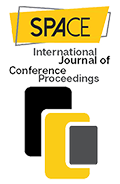Conducting Heritage Tourism-Led Urban Renewal in Historic Urban Spaces: A Case Study of Datong, China
DOI:
https://doi.org/10.51596/sijocp.v1i2.28Keywords:
heritage tourism-led urban regeneration, Chinese historical urban landscape, reconstruction and preservation of urban space, urban history and cultural resources, place identityAbstract
To boost the local fiscal revenue through capital investment promotion, urban renewal/regeneration led by heritage tourism has become a critical way of creating the city brand, designing tourism destinations, and attracting property developers and investors to cities. However, current practices lack proper understanding and consideration in preserving and interpreting the authentic identity in urban China in recent times. This has led to simply copying and pasting historical forms and urban spaces, thus resulting in an identity crisis due to the reproducibility of tangible heritage – physical form, architectural style, superficial living style, etc. Against this backdrop, this research explores the involvement of both tangible and intangible heritage rooted in historical Chinese cities which are undergoing heritage tourism-led urban regeneration. It also attempts to understand the influences of authentic intangible heritage – social activities, cultural events, collective memories and others – in designing and shaping urban spaces to preserve and reconstruct the place identity.
To achieve these aims, a conceptual framework based on the relevant concepts relating to historical heritage and culture-led urban regeneration was developed to lead the research. Moreover, this research will examine and assess concepts and themes developed from the conceptual framework by employing qualitative research methods (including semi-structured interviews, on-site observation and photography, and analysis of relevant planning and designing schemes) in the case study of heritage tourism-led urban renewal in the old town of city Datong, China.
A new conceptual framework was then developed in this research, contributing to the field of urban regeneration and place identity in both theoretical and practical aspects. The developing process of the conceptual framework and its findings help to provide a theoretical way of exploring the manifestation of local history and cultural resources in preserving and reconstructing the place identity of the Chinese historical urban context undergoing heritage tourism-led urban regeneration.
References
Aelbrecht, P. S. (2016). ‘Fourth places’: the contemporary public settings for informal social interaction among strangers. Journal of Urban Design, 21(1), 124-152.
Al-Hagla, K. (2010). Sustainable urban development in historical areas using the tourist trail approach: A case study of the Cultural Heritage and Urban Development (CHUD) project in Saida, Lebanon. Cities, 27(2007), 234-238.
Carmona. M. (2010). Contemporary Public Space, Part Two: Classification. Journal of Urban Design, 15, 157–173.
Carr, S., Francis, M., Rivlin, L.G., & Stone, A. (1992). Public Space. Cambridge: Cambridge University Press.
Hague, C., & Jenkins, P. (Eds.). (2005). Place Identity, Participation and Planning. Routledge: Abingdon.
Jiaming, S., & Scott, L. (2013). Chinese Globalization, A Profile of People-Based Global Connection in China. London: Routledge.
Liu, H., & Wan, Q. (2006). Reconsidering the Conservation and Planning System for ‘Historic and Cultural Cities’. In H.X. Yang & X. Liu (Eds). Collection of International Symposium on Conservation of Historical Cities and Buildings (pp. 24-28). Changsha: The University of Hunan Press.
McCarthy, J., (2005a). Promoting image and identity in cultural quarters: the case of Dundee. Local Economy. 20(3), 280-293.
Mehta, V., & Bosson J. K. (2010). Third places and the social life of streets. Environmental Behaviour. 42(6), 779-805.
Montgomery, J. (2003). Cultural Quarters as mechanisms for urban regeneration. Part 1: Conceptualising Cultural Quarters. Planning Practice & Research, 18(4), 293-306.
Kana, K. (2012). An experiment in urban regeneration using culture and art in Senba, Osaka’s historic urban centre, with a focus on the regeneration of urban space. City, Culture and Society, 3, 151-163.
Qian, F. (2007). China’s Burra Charter: The Formation and Implementation of the China Principles. International Journal of Heritage Studies, 13(3), 255-264.
Oldenburg, R. (1989). The Great Good Place: Cafes, Coffee Shops, Bookstores, Bars, Hair Salons, and Other Hangouts at the Heart of a Community. New York: Marlowe.
Sepe, M., (2013). Urban history and cultural resources in urban regeneration: a case of creative waterfront renewal. Planning Perspectives, 28(4), 595-613.
Sepe, M. (2017). Place identity and creative district regeneration: the case of 798 in Beijing and M50 in Shanghai art zones. METU JFA, 35(2), 151-171.
Wang, S., & Gu, K., (2020). Pingyao: The historical urban landscape and planning for heritage-led urban changes. Cities, 97, 102489.
Wansborough, M., & Mageean, A. (2000). The role of urban design in cultural regeneration. Journal of Urban Design, 5(2), 181-197.
Xie, J., & Heath, T. (2017). Conservation and revitalisation of historic streets in China: Pingjiang Street, Suzhou. Journal of Urban Design, 22(4), 455-476.
Zhai, B., & Ng, M. B. (2013). Urban regeneration and social capital in China: A case study of the Drum Tower Muslim District in Xi’an. Cities, 35, 14-25.
Published
How to Cite
Issue
Section
Categories
License
Copyright (c) 2021 Hao Lei, Youmei Zhou

This work is licensed under a Creative Commons Attribution 4.0 International License.













